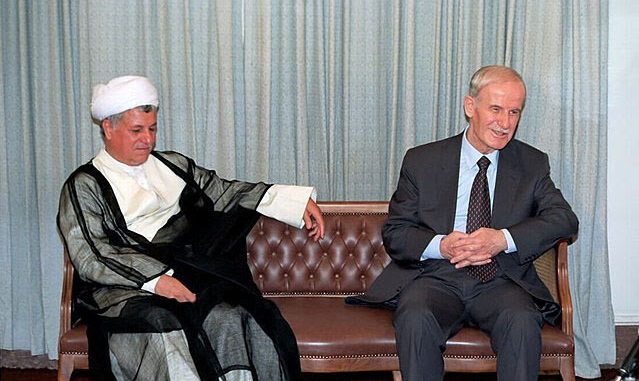by Anna Borshchevskaya, Middle East Quarterly
Spring 2023 (view PDF)

Syria’s Hafez al-Assad (right) and Iranian president Akbar Rafsanjani, Tehran, 1997. Syria was the first Arab state to recognize the Islamic Republic of Iran.
Both Russia and Iran have deep, multifaceted, and long-standing connections to Syria. During the
Cold War, Damascus emerged as the Soviet Union’s most loyal Middle Eastern ally, and the relationship regained vibrancy in the 2000s as Vladimir Putin strove to reestablish Moscow’s regional preeminence.
Meanwhile, the 1979 Iranian revolution reversed Tehran’s pro-U.S. orientation. Hafez al-Assad’s Syria was the first Arab state to recognize the Islamic Republic of Iran and the only Arab state (apart from Libya) to support Iran during its 8-year war against Iraq (1980-88). In subsequent decades, Tehran intensified its political, economic, and military ties with Damascus.
The Syrian civil war ushered in a new era in Moscow and Tehran’s relations with Damascus as both states used their military intervention in the conflict to deepen their Syrian entrenchment. And while the Ukraine invasion has made Moscow dependent on Tehran’s military support, rather than lead to any disengagement from Syria, this strategic reconfiguration has intensified the Iranian-Russian security collaboration in general and in Syria in particular. This is bound to have far-reaching implications not only for the decade-long Israeli-Iranian “quiet war” in Syria but for the entire Middle East.
Continue reading the full article>
Anna Borshchevskaya is a senior fellow in the Diane and Guilford Glazer Foundation Program on Great Power Competition and the Middle East at the Washington Institute for near East Policy and author of Putin’s War in Syria: Russian Foreign Policy and the Price of America’s Absence (I.B. Tauris, 2021)
<
>



Leave a Reply
You must be logged in to post a comment.